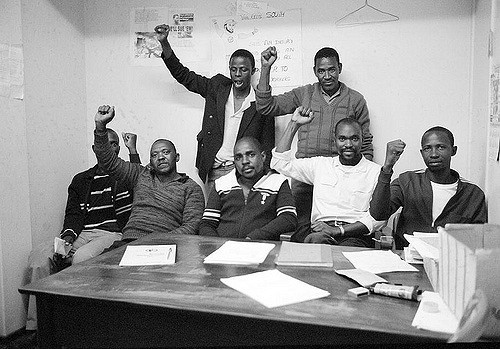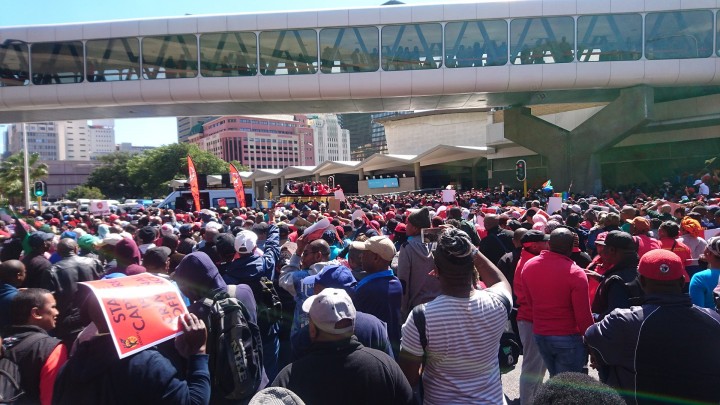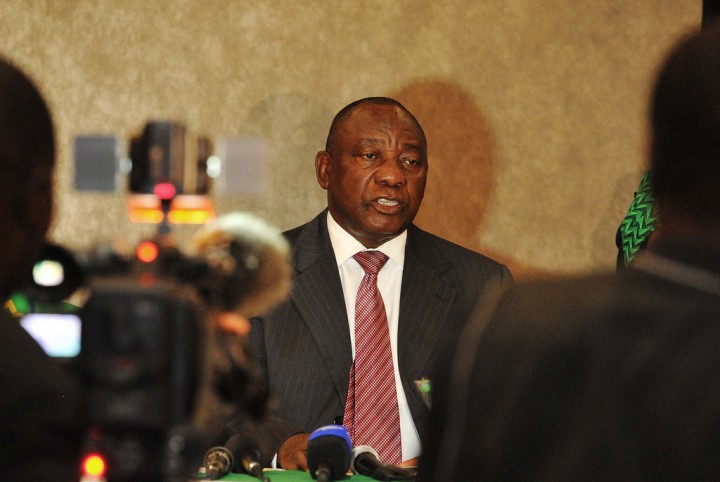A wave of optimism has swept across South Africa since Jacob Zuma resigned as president of the country last Wednesday. There was a collective sigh of relief that the 9-year scandal-ridden presidency of Zuma was finally over. Middle-class commentators said that a ‘new dawn’ has arrived. But Marxists have explained many times that the crisis facing South Africa is not that of an individual, a single political party nor one section of the ruling class. The political crisis is only an expression of the crisis of the capitalist system as a whole. And as long as the system survives, changes at the top will not result in changes of anything fundamental.
“The more things change, the more they stay the same.” – Jean-Baptiste Alphonse Karr
The big capitalists are over the moon that Cyril Ramaphosa has succeeded Jacob Zuma. This is no surprise. Ramaphosa is a trusted representative of big business. He has played a key role in defending the interests of the capitalist class in the ANC and in the labour movement for the last 30 years. This in itself, should set the alarm bells ringing for the working class. Instead of falling for the wave for petty-bourgeois illusions in Ramaphosa, the leaders of the working class should prepare to fight. As Marx and Lenin explained many times, the interests of the capitalists and the interests of the workers cannot be reconciled.
From working class leader to mining capitalist
Ramaphosa was a founding member of the National Union of Mineworkers. In the dying years of the apartheid regime, he led the biggest strike in history at that time. He led the union in the face of a brutal onslaught by the regime. He was also instrumental in the founding the Congress of South African Trade Unions (COSATU). He made very radical and even revolutionary sounding speeches in the early days of COSATU.
The formation of COSATU in the mid-1980s was a game changer for the South African workers. It came in the context of a revolutionary upheaval across the country. In the end, it was the revolutionary mobilisations of the working class in the 1980s and 1990s which led to the overthrow of the apartheid government. All of this earned Ramaphosa, and the labour leaders enormous authority. But the Ramaphosa of today is no friend of the working class, but a traitor of the workers’ movement.
 Members of the National Union of Mineworkers during Apartheid / Image: Flickr, UN
Members of the National Union of Mineworkers during Apartheid / Image: Flickr, UN
The leaders of the ANC, COSATU and the SACP, including Ramaphosa himself, used all their political authority to hold back the mass movement from challenging the foundations of the capitalist system itself. Instead of bringing together all the forces of the South African working class to bring an end to capitalism in the country, in the end they made a deal with De Klerk.
This deal at the CODESA negotiations in the 1990s between the apartheid regime and the liberation movement resulted in the negotiated settlement of 1993. Ramaphosa was the lead negotiator for the ANC at the CODESA negotiations. The basis for this negotiated settlement was a guarantee in the constitution to defend the right to private property. This secured the continued domination of the traditional white bourgeoisie over the economy while the liberation leaders got access to high political office. This ‘elite pact’ formed the basis for capitalist rule over the past 25 years.
The working class movement of the 1980s challenged the very existence of capitalism in South Africa. This terrified big business. They realised that the only way to prevent a revolutionary overthrow of the system was through negotiations with the ‘pragmatic’ leaders of the liberation movement, such as Ramaphosa, Mbeki and Mandela.
After the so-called ‘democratic transition’, Ramaphosa was handsomely rewarded by big business for his role in quelling the mass revolutionary movement of the working class of the 1980s and 1990s. Through the Black Economic Empowerment Programme, he went into business and created a multi-million dollar empire. He became a mine-owning billionaire, amassed a fortune and became one of the richest men in the country. This is a typical example of how the capitalists bribe the leaders of the working class to use their political authority to keep the masses at bay – especially during periods of revolutionary crises.
Shaky ground
After the first non-racial elections in 1994, the ruling class, in conjunction with the leaders of the ANC, managed to stabilize the situation for a period of more than a decade on the basis of a growing economy. The average real GDP growth rate for the decade after 1994 was 3 percent, and in per capita terms it was 1 percent. This represented a substantial improvement over the previous 10 years. In the dying years of the apartheid regime (1984-93), trade and financial sanctions imposed on the government, as well as the revolutionary upheavals, had contributed to the worst ten-year growth performance since the Second World War. During this period (1985-94) the average growth rate was 0.8 percent, and -1.3 percent in per capita terms (Statistics from the Bureau for economic research, Stellenbosch University, 2006)
The debt-fuelled consumption boom, together with all attempts by the ANC leaders to channel the workers’ movement on a bourgeois democratic path, meant that a full-blown revolutionary overthrow of the system was averted. The democratic reforms that were won were a by-product of the heroic struggles of the the workers in this period. The working class was never defeated and their organisations came into the new era intact. This is an important factor in explaining the upsurge in the class struggle from 2009 onwards.
Marikana
Then came the infamous Marikana massacre of mineworkers in August 2012 which took place during a massive upsurge in the class struggle. Ramaphosa was a key figure in creating the atmosphere that was to lead to the killing of those mineworkers. He wrote emails to Lonmin executives and the Minister of Police, calling the strike “dastardly criminal” and called for “concomitant action” to be taken against the strikers. He used his political clout to put enormous pressure on the police to break the strike. His intervention had a direct impact on the outcome of events.
The police came prepared to break the strike with savage violence. They clearly anticipated a blood bath. On the morning of the strike they even ordered four large mortuary vehicles, with a capacity to hold more than 30 corpses, to the scene. Less than 24 hours after Ramaphosa’s call for “concomitant action”, the police shot 112 striking workers, wounded 78 and killed 34. Then they arrested hundreds of other workers and charged them with “having common purpose” in murdering their comrades!
This was the most brutal and open betrayal of the working class by someone who used to be a trade unionist. It shows which class he really represents. In the class struggle one cannot serve two masters. Either you serve the interests of the workers or you serve the interests of the capitalists – you cannot do both. No amount of sweet words in parliament will ever change Ramaphosa’s involvement in this massacre.
The mass movement returns
The explosive rise in strikes, protests and demonstrations in this period showed that the workers were willing to fight back against the onslaught from the ruling class. For the black masses, who had overthrown a vicious dictatorship through their own strength, the limited success after 1994 in the provision of basic services such as water, sanitation and electricity was not enough. On the contrary, it only emboldened them to put forward other demands like higher wages, housing, etc. However these demands came up against the laws of capitalism. Under the so-called ‘cost containment measures’ and the ‘user-pay principle’, basic services like electricity and water were cut off to millions of households that could not afford to pay. In an economy which was built on the basis of cheap, abundant, black labour, the result was a sharp increase in the protests and demonstrations in working class areas.
This spilled over into the political arena. In the period between 2005 and 2007 there was upheaval in the ANC as the rank and file tried to change the pro-capitalist macroeconomic policies and the direction of the the ANC government. Under immense pressure, a left-wing alliance developed between the ANC Youth League, the SACP, and the COSATU unions. This culminated in removing the pro-capitalist leadership of Thabo Mbeki at the Polokwane conference of the ANC in 2007.
 COSATU protest in Cape Town / Image: Discott
COSATU protest in Cape Town / Image: Discott
The movement of the masses coincided with the global economic collapse of 2008. This had a big impact on the South African economy, which entered into recession for the first time in nearly 20 years in late 2008 and early 2009, when GDP declined for three straight quarters: the fourth quarter of 2008 (-2.3 percent), the first quarter of 2009 (-6.1 percent), and the second quarter of 2009 (-1.4 percent).
The effects of the slowdown in the economy were felt immediately. Output in the mining sector contracted by a record 33 percent in the last quarter of 2008. The manufacturing sector contracted by 22 percent. Consumer spending fell by almost 5 percent, its biggest contraction for 13 years. Company failures rose by 47 percent in the first four months of 2009 and household debt rose sharply. The effect of all of this was immediately felt by the working class in the form of more than one million job losses.
The sharp rise in the class struggle and the militancy of the workers in this period transformed the political situation. The ANC began to fragment along class lines. After Thabo Mbeki was recalled as president of the country in 2008, a section of the liberals broke away to form a new party on the right, the Congress of the People. However the pendulum was swinging to the left. The Polokwane coalition of the SACP, Cosatu and the ANC Youth League began to unravel. The ‘communist’ leaders joined the new administration of Jacob Zuma as Ministers and Members of Parliament where they carried out the capitalist policies of the government. The Cosatu unions went through a big split, with the metalworkers’ union, Numsa, forming a new labour federation after they were expelled from Cosatu. Some expelled leaders of the ANC Youth league, like Julius Malema, formed a new party, the Economic Freedom Fighters. In this way the former liberation movement fragmented to the left and the right.
Impact on the ruling class
This has had a big impact on the ruling class. For the last two decades, the big capitalists ruled society indirectly through the leaders of the ANC. With the ANC having a near monopoly on the support of the masses of black people since the 1950s and, in order to hold the masses back, it was imperative for the ruling class to keep the ANC together for as long as possible. However, it is not possible to reconcile the interests of workers with those of the capitalist class. In the end, it is the very capitalist policies which the ANC have followed as the governing party, which are now tearing the party apart.
A massive split erupted between the traditional capitalist wing, which has a monopoly on the most profitable sections of big business on the one hand, and the upstart, junior wing of the ruling class around President Zuma and the Gupta family which has been making money from corruption through the state tender system, on the other hand. As the economy slowed down over the last period, the big capitalists started to demand an austerity budget: i.e. a cut in government spending. This demand came into conflict with the junior wing of capitalists which had grown fat on looting the state. The result was a massive conflict within the ruling class which has dominated South African politics over the last few years.
Prepare to fight!
Meanwhile Ramaphosa had returned to active politics. In 2012 he was elected as Deputy President of the ANC in Mangaung. Now, after he defeated Zuma’s candidate in December, he is president of the ANC. Big business now has a direct representative at the head of the governing party. No wonder big business is ecstatic!
This is why the working class must remain vigilant. It is a time to mobilise. A Ramaphosa presidency will mean a more able, effective and conscious pursuit of the interests of the ruling class – without the personal scandals and open looting of Zuma. Big business will look to consolidate their position and try to reverse the economic decline. The only way they they will be able to do this is by attacking the working class.
 Petty-bourgeois illusions in Ramaphosa will burn in the raging inferno of the class struggle / Image: Flickr, GovernmentZA
Petty-bourgeois illusions in Ramaphosa will burn in the raging inferno of the class struggle / Image: Flickr, GovernmentZA
Already they are preparing big changes to the country’s labour laws, which collectively represent a direct attack on the working class. Two of the bills affect the workers’ right to strike. This includes the introduction of strike ballots and the creation of an ‘advisory arbitration panel’, which employers can approach without having to engage with workers first. The decision of this arbitration panel will be binding. Additionally, the government is preparing to introduce a severe austerity budget. This will be a declaration of war on the working class.
However, all this will be easier said than done. The working class will not give up their right to strike without a bitter fight. Ramaphosa’s first task is to stabilize the situation. The ruling class is still walking on shaky ground. Every attempt by to stabilise the economic equilibrium will lead to the destabilisation of the social and political equilibrium. The petty-bourgeois illusions in Ramaphosa will end up in the raging inferno of the class struggle.
South African capitalism is in deep crisis. The root cause of this is the CODESA agreement of the 1990s where the movement of the workers was diverted from its revolutionary path. Now 25 years later, the ANC has lost most of the moral and political authority it acquired during the Mandela era. So, while big business is relieved that their preferred candidate walked away as ANC president in December, they realise that the ability of the party to hold back a future mass movement of the working class is severely weakened. Therefore, big battles lie ahead. The crisis of the party now reflects the crisis of the system itself. This has revolutionary implications for society as a whole.
